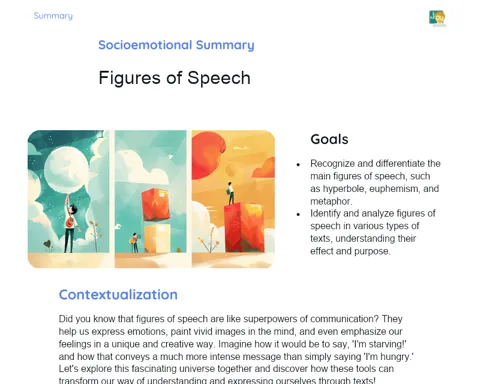Syllable Formation | Active Summary
Objectives
1. 🔍 Understand what a syllable is and identify the syllables of any presented word.
2. 🧩 Develop word segmentation skills, perceiving how they are formed by syllables and how these units are essential for fluent reading and writing.
Contextualization
Did you know that syllables are like the bricks that form words? Each syllable is a fundamental building block in our language, and understanding how they are organized is crucial for reading and writing well. For example, the word 'computer' has 4 syllables (com-pu-ter). This skill is not only vital for literacy but also for poetry and music, where rhyme and meter depend on precise knowledge of syllables.
Important Topics
Syllable
A syllable is a segment of speech that contains a vowel nucleus and can be formed by one or more letters that are pronounced together. For example, in the word 'bed', we have one syllable: bed. Understanding syllables is fundamental for the correct division of words, which facilitates reading and writing.
-
A syllable can be classified as open (ending in a vowel) or closed (ending in a consonant).
-
Syllabic division is essential for learning new words and correct pronunciation.
-
Knowledge about syllables is crucial for fluency in reading and writing, in addition to being the basis for correct spelling.
Word Segmentation
Segmenting words into syllables is the process of dividing words into smaller units, the syllables, to facilitate reading and writing. This aids in phonological understanding and improves pronunciation, especially for children in the literacy phase.
-
Correct segmentation directly influences text comprehension and vocabulary acquisition.
-
Practicing word segmentation helps identify phonetic patterns and improves the ability to spell words.
-
It is an important technique for studying foreign languages, where correct pronunciation is fundamental.
Interactive Activities
Incorporating interactive activities into the study of syllables helps maintain student interest and participation, making learning more dynamic and effective. Games, puzzles, and simulations of real reading and writing situations are excellent ways to apply knowledge about syllables in a practical and fun manner.
-
Word games and puzzles help solidify knowledge about syllabic formation.
-
Simulations of real reading and writing situations stimulate practical application of syllables.
-
Interactive activities promote collaboration among students and the development of social skills.
Key Terms
-
Syllable: Sound unit that forms words, composed of one or more letters.
-
Syllabic Division: Process of separating words into syllables.
-
Segmentation: Act of dividing words into smaller parts, facilitating reading and writing.
To Reflect
-
How can the ability to segment words into syllables help in learning new vocabulary?
-
Why is it important to understand the differences between open and closed syllables in the Portuguese language?
-
In what way can interactive activities transform students' perception of the importance of syllables in language?
Important Conclusions
-
We reviewed the concept of a syllable, understanding that it is the basic unit of speech and writing, essential for the correct division of words.
-
We explored how segmenting words into syllables helps improve reading, writing, and pronunciation, highlighting the importance of this knowledge for effective communication.
-
We discussed the relevance of interactive activities in learning syllables, recognizing how they make study more dynamic and applicable in everyday life.
To Exercise Knowledge
Create a small syllable dictionary. Choose 10 words from your book or magazines and break them into syllables. Try to identify whether the syllables are open or closed. Then, use these syllables to form new words and discover what they mean!
Challenge
Syllable Detective Challenge: Ask your family or friends to read a list of words. Try to guess how many syllables each word has just by listening. Then, check with the correct division and see how many you got right!
Study Tips
-
Practice word segmentation during daily readings. When you find a new word, break it into syllables to help with pronunciation and better understand its meaning.
-
Use online educational games that focus on syllables and phonetics to make learning more fun and interactive.
-
Draw a mind map or make cards with syllables and words to visualize and better memorize syllabic divisions.



